Just when you
thought that not one more drop of nectar could be squeezed from the
Brady fruit, here comes along yet another book about the Bunch. But
this one’s with a twist.
Brady, Brady, Brady
(Running Press) is co-authored by series producers (and father and
son) Sherwood and Lloyd Schwartz. It tells the story of a lovely
lady, but from behind both the camera and the executive desks.
However, the book
is not a business-like account. It’s chock full of drama that could
make for a sitcom itself: the challenge of working with children,
the changing television landscape of the 70s, the watchful eye of
network executives, a difficult cast member who hated the show (and
its producers), and even a real-life crime scene and dead body. And
you’ll also learn why you almost never see the Brady kids all in one
room at the same time – even though you think you did.
The phenom
started as a newspaper article that Sherwood Schwartz had glanced at
in The Los Angeles Times in 1966. Sherwood, who was winding up his
production of his series Gilligan’s Island, read that a good
portion of American families were “blended,” that is, a combination
of two families. He was astounded that other television producers
were not jumping on this idea, but for him, it was much more than a
hunch. And a few years later, The Brady Bunch was born, in
color.
Though barely
noticed during its original five-year run on ABC (1969-1974), it
managed to live forever. It would eventually morph and reinvent
itself and withstand criticism and never die.
Here, Lloyd J.
Schwartz talks about the book and the Bunch, and what the experience
meant for him as a very young executive producer who ran a network
series with his father. And its decades of blessings, misfires,
connections and consequences.
What makes the
book different from other Brady accounts?
It’s kind of a
neat book because it’s written by two different authors with two
different points of view. It’s more “behind the scenes” because so
many of the Brady books were written by people who were not there.
This was our chance to get the producers’ side of the story out
there.
How is Dad
doing?
Just great. He’s
93. He doesn’t run around a lot. He’s very alert, but he just leaves
his house a few times a week for some kind of activity. My mom is
still alive and she’s 91. They’re both full of vim and vinegar. I’m
happy to have them around.
How have you
been keeping busy lately?
The Gilligan’s
Island [feature film] will be coming up soon, so we’ll be
executive producing that. We do a lot of theater. I have a
children’s theater with my wife and that keeps us busy all the time.
It looks like we will be doing the Gilligan [stage] musical
in Maui and now we’re also talking about raising money for Broadway.
What’s the
latest on The Brady Bunch stage musical?
We have all the
money, and I have Barry [Williams] and Maureen [McCormick] to play
the parents, but CBS, who has the copyright, won’t let us do it. And
you’ll have to ask them why. It only played in a theater in Los
Angeles so far, and got very good reviews and received all kinds of
awards, got very big houses. Paramount and CBS, who are not doing
anything with Brady, said no. So if you want to ask them why, you
will get a better answer than I can give.
Why does
The
Brady Bunch survive after forty years?
It was one of the
very first family shows that talked about the family from a kids’
point of view. Most other shows, even the ones today, are from the
mother or father’s point of view. But here, the parents get involved
in the kids’ stories. And that was unique.
It was a blended
family, but after a while, people would just think that it was a
family. It was also one of the first family shows in color, so it
didn’t get dated in the way that some of the black-and-white ones
did.
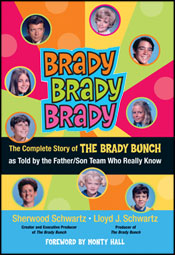 I
actually kid dad, saying, “What did you put in the film?” There must
be some kind of addictive thing in the film that gets people to
watch it so much!
I
actually kid dad, saying, “What did you put in the film?” There must
be some kind of addictive thing in the film that gets people to
watch it so much!
It never got very
high ratings when we were actually on first run. When it went into
syndication, that’s when it took off and people were watching it two
or three times a day. Then it became a monster kind of a hit.
[During the
series run], we were in a protected environment. We were on a stage
and we seldom got out of there. And we didn’t get big ratings and
there was no big publicity. It never dawned on me that we were
making an impact. However, that said, as the show was going along, I
was saying to myself, you know, maybe I should try to remember some
of this. Someday, somebody might be interested.
TV
entertainment in 1969 was about to go though some intense changes.
The move was toward socially relevant, urban, ethnically centered
programming, and
The Brady
Bunch didn’t figure into this. Were you at odds with your gentle,
mild, family-oriented show surviving in the climate of such a sea
change?
I was in college
during the 60s. I was even part of a black-white comedy team and it
was pretty radical. I am enough of a chameleon, I think, to fit into
the mindset that my dad had and I knew it very well. Many of the
stories came from my own family so it was really kind of a home
movie in some way.
One time, there
was a war moratorium because the Viet Nam war was going on. I was
political, so I wanted to wear a black armband to work to show my
support of the moratorium. So I did, and then I got a call from the
head of the studio who said, “What’s with the black armband?” And I
immediately go into my political “I have the right to show and say
whatever I feel…” And he said, “I don’t give a shit about that. The
network executives are coming by the studio and I don’t want them to
think your father died.” So I took off the black armband!
We were on the
air exactly the length of the Nixon administration, but we were not
impeached.
What was it
like for you to work with children?
That’s one of the
reasons that I’m tired! One of my first jobs on the show was as a
dialogue coach. Dad had wanted somebody who had worked with children
before. I had run a summer camp. I had also been a dialogue coach
and I also had performing experience. And he wanted someone young.
He was also very
smart in that he did not have character descriptions for the kids.
He wrote the show the way the kids really were.
Also, it was very
important that we never treated them like anything except children.
We made the whole thing fun for children. We wanted that attitude to
be on the screen. We were always playing games and running all
around and getting into trouble on the lot, because it was like a
playground.
I was called on
the carpet by the president of the studio. That happened to me with
some regularity. He said, “The kids are running all around and they
are very expensive property.” And my back went up. I said, “They
are not property. They are kids. And they are not going to stop.”
And I had no idea why I was challenging authority, maybe because I
was used to doing that in college. But I stood up to him. I said,
“They are going to stay kids. I don’t want them to break their arms,
but they need the chance to break their arms. Because that’s what
kids do.” We never missed a day. We were never went over [schedule],
and they were terrific.
What was a
typical production schedule for an episode?
The schedule was
broken down mainly because of the kids and the number of hours they
had. They would come in at staggered hours. We would also have to
get their schooling in.
One thing you
didn’t see in the show – which you think you did – was the kids
running around together all the time. That happened once an episode,
maybe. We would actually film with the girls one time and the boys
another time and stagger them. And at the end of the day, the adults
would do their scenes. We only had the kids for a certain number of
hours.
We had a
wonderful teacher named Francis Whitfield. She was actually on one
episode, playing a teacher who was retiring. She had been in SAG
[Screen Actors Guild] and she had to reactivate her membership [for
this episode]. She was a fabulous woman and we had a great
relationship.
If you watch the
show during its first couple of years, the kids did everything
mostly in close-ups. They didn’t have a lot of experience, so it was
enough to try to get the readings out of them. As time went by, they
were able to work with each other in two’s and three’s.
It would have
been difficult to have a live, three-camera show in front of an
audience with kids. They would get distracted. We really wanted them
to be focused on what they were doing.
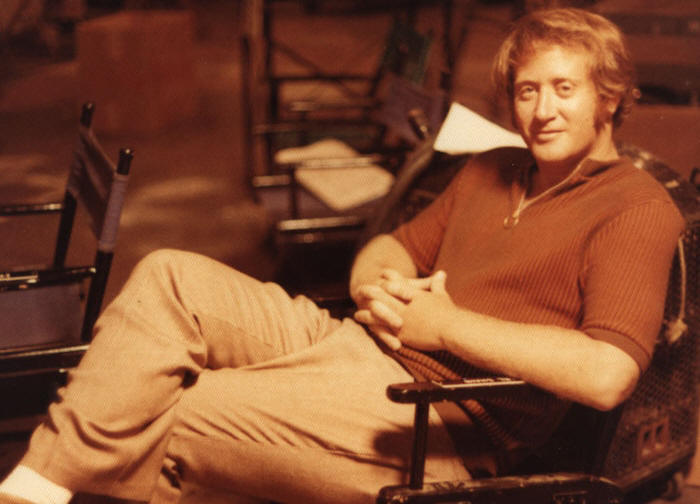 As
the series went on, the kids began to dress more “groovy.” Of
course, this look has become infamous. Was there any conscious
decision at the time to dress the kids in a more stylish, hip way
(for the era)?
As
the series went on, the kids began to dress more “groovy.” Of
course, this look has become infamous. Was there any conscious
decision at the time to dress the kids in a more stylish, hip way
(for the era)?
We went with the
time we were living in, when clothes started getting a little
wilder. Also, the kids started to get more clothes conscious
themselves. You can put anything on a little kid and they’re fine.
But as they get older, they get more concerned about it. Again, we
were reflective of the era. And people were wearing bell bottoms and
clothes like that, where they weren’t at the beginning. It was
nothing that I thought much about. Now that I look at reruns, I
think about it. And I think, “What are they wearing?”
The design of
the Brady house is one of the most recognizable in television
history. In fact, the floor plan itself is often integrated into the
plot. How did that come about?
Dad considers the
set another character. I was not there for the decision. I arrived
for the first episode after the pilot. I was in college and not
around for the pilot. When I arrived, the set was already there. He
had an image [in his mind of the family] running up and down the
stairs.
The exterior of
the house, which you see in the stock shot, is actually only a
one-story house. We hung a window on it to make it look like a
two-story house.
Dad wanted it to
be modern, and the father was an architect, so he wanted something
that the architect could have designed, which he did. There are a
lot of jokes about this guy being an architect: six kids and one
bathroom. And no toilet!
Tell me about
the episodes that never were. What was on the drawing board that
never happened?
They were
starting to talk about [Brady mom] Carol getting pregnant. And I
think there may have even been a script written. I’m not sure about
it. We were planning on that kind of thing.
Since the father
was an architect, I had thought about, in the sixth year, taking
them out of the house and traveling them around the country. He
would be commissioned by the United States to get involved
architecturally in famous places, like Niagara Falls. This was
because I felt that there was nothing more American than The Brady
Bunch. And I think that would have given the show additional life.
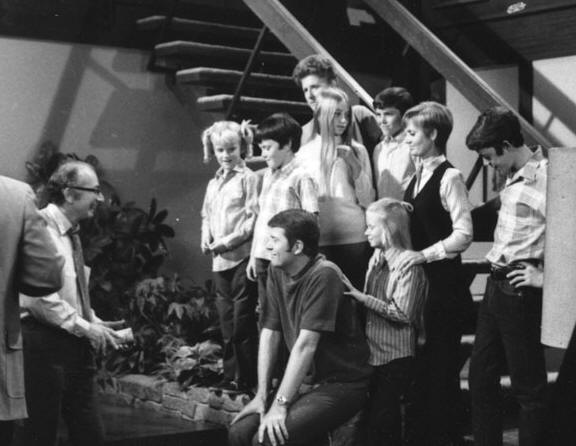 Like many
shows of that era, you introduced a younger character (Robbie Rist
as Cousin Oliver) as the cast grew older. Was that your decision?
Like many
shows of that era, you introduced a younger character (Robbie Rist
as Cousin Oliver) as the cast grew older. Was that your decision?
It was a network
directive. They wanted to make sure the show was fresher and we
needed younger characters.
I’m glad that the
show went off after five years. It felt complete.
Robbie gets a bum
rap, but he was really good. He did exactly what we wanted him to
do.
Most everyone
remembers the Brady vacations, to the Grand Canyon, Hawaii and
King’s Island Amusement Park (in which you played a very small part
as a park employee). Was it a challenge to film on location?
It was all fun.
It was like a vacation, because everybody loved each other.
Most of the Grand
Canyon episodes were not filmed there. The ghost town was at
Paramount. The bottom of the Grand Canyon was actually Franklin
Canyon in LA. For the burro ride, we only went down about a hundred
feet. We only pretended that they went all the way down, because it
takes a whole day to get down to the bottom. We were only there a
day or two. For the car driving shots, I doubled as Robert Reed.
They dyed my hair black.
In Hawaii, the
sun went down pretty early there and everybody wanted to party!
The King’s Island
one came about because they came to us and they said, “We will pay
for everything over your normal budget if you come here and do an
episode.” The only reason I was in it was because [had we used real
actors], it would have meant casting somebody, paying their airfare,
paying all this extra money, so we kind of just acted. It was an
eye-opening experience for me. I hadn’t acted except for one class
in college. I recommend any writer, producer or director to act a
little bit to understand what it is.
The spin-off
attempt, called
Kelly’s Kids,
was about a couple who adopt three boys of different races. The
pilot never made it to the prime-time schedule. What happened there?
It later on
evolved into a series called Together We Stand that dad did.
I was on another series at the time. It didn’t last very long.
Elliott Gould was in it for a while. Every pilot we did, except for
one, got on the air in some way.
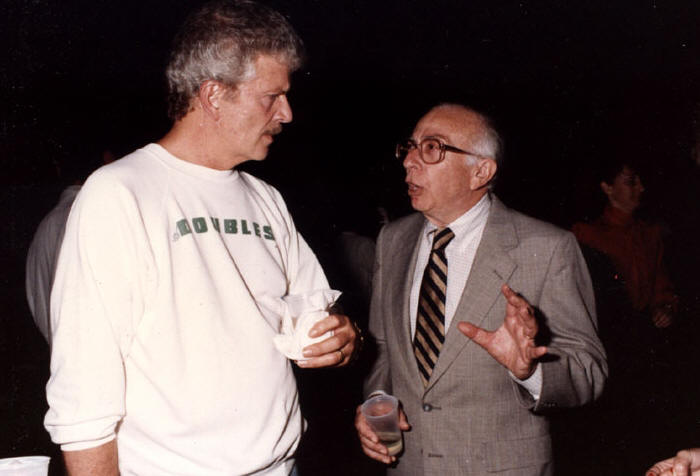 The story is
rather well known by now of how Robert Reed loved the cast but hated
the show. What was your experience with him on set?
The story is
rather well known by now of how Robert Reed loved the cast but hated
the show. What was your experience with him on set?
Imagine if you
are twenty-one or twenty-two years old, and you’re on the set and
everybody knows that you are the son of the producer. And you have
an actor who is screaming invectives, really unpleasant, and
insulting your dad and you’re there in front of everybody. It was
horribly awkward and painful.
He was very
bright, a Shakespearian-trained kind of guy. I knew that I could
never get into any kind of argument with him because he would win. I
didn’t have the facilities to handle it, so I would just avoid it; I
would avoid him.
Florence [Henderson, who played Carol Brady] would ask us how to handle him,
because she found it all very difficult also. Dad and I both said,
“Just agree with him.”
Dad believes that
the show was better because [Reed] was in it. We disagree on that,
because I didn’t think that he was particularly good. Dad thinks he
presented the strong father figure, which was good. But we never got
any comedy from him. He couldn’t carry a show because people weren’t
interested in a stiff guy who was just the father of these kids. It
was just about the kids and how the father and the mother work into
it.
My relationship
with him was always very awkward. Talking to him was very awkward.
Several times he tried to get me fired. Some of that is pretty
deeply psychological because the better part of him was Mike Brady.
He had a very complicated personal life. I won’t go into it; that’s
been reported anyway. His life was so complicated that he, in some
ways, saw Florence as his wife and the kids as his kids. [He thought
it was] his show. He was Brady. Well, in truth, it’s the producer’s
show. If there is a battle between the producers and the star,
usually the star wins if he has his name on it, like The Andy
Griffith Show. But he wanted to get rid of us. He wanted to get
rid of me. He demanded that I be fired, and he tried to get rid of
Dad.
At one point,
which Dad told me about much later, [Reed] went to the studio and
said, “It’s either Lloyd or me.” The studio said, “We’ll keep
Lloyd.”
It was just
horrible. Sometimes we would have to stop and come up with other
lines. He would write these long, long letters full of invectives
about the script. It was supposed to be a comedy, but he wanted all
the comedy out of it. He would be happy if he just lectured the kids
all the time.
It’s not that he
wanted to make the show better; he wanted to make the show totally
realistic. That’s like watching paint dry.
Unfortunately, he
knew that Dad produced Gilligan’s Island, which was a much
broader kind of show. Reed didn’t want to turn the show into
Gilligan’s Island. But it never was. It was a gentle family
show with a lot of values. Again, Dad gives him a lot of credit for
being a strong father, but I think he could have been a strong
father with some kind of humor to him.
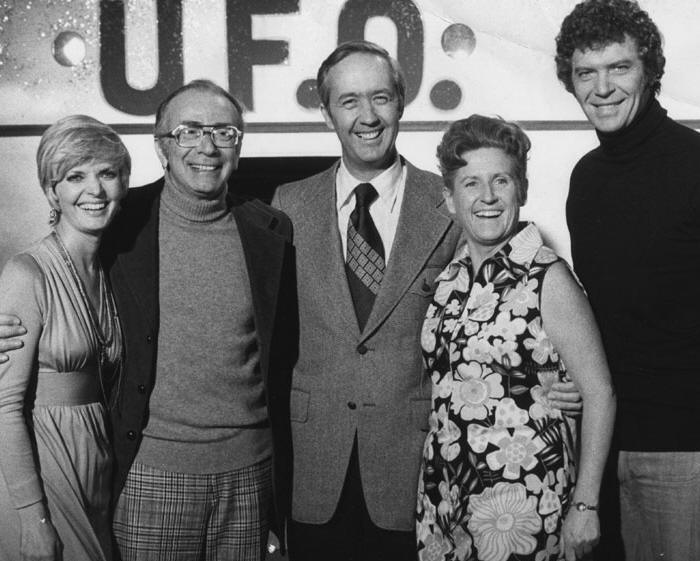 I guess you
had the completely opposite experience with Ann B. Davis, who played
Alice. She seemed like a real trouper, and she made the most of
every one of her scenes.
I guess you
had the completely opposite experience with Ann B. Davis, who played
Alice. She seemed like a real trouper, and she made the most of
every one of her scenes.
I have a
wonderful relationship with her to this day. She comes to the kids’
weddings and bar mitzvahs. She lives in a religious community. She’s
not a nun, but she was very happy when she left show business and
started doing that.
She was a
wonderful comedienne and a favorite of Dad’s and mine. She was
Schultzy on The Bob Cummings Show. That’s where I knew her.
Dad had an opportunity to get her for the show, and I went crazy!
They had to spend a little bit more money [to get her].
The reason that
she was so important was that Florence is warm and wonderful and can
handle a joke, but she is not in herself a funny person. That’s not
a negative comment. Dad knew that we needed some humor in the
kitchen, and that’s why Ann B. was called into service.
Her attitude was
exactly the opposite of Robert Reed’s: writers have worked a long
time and this is what they have come up with. She did not make any
judgments. We were paying her to put this over the top, this kind of
material, whatever it is. Now Robert Reed would look at the script
and say, “I think this is crap and I’m going to play it like that.”
That’s a different attitude.
Annie and I had a
secret communication on the set. The directors were transient. They
would do an episode and move on to another series. They didn’t have
The Brady Bunch to their soul. And so Annie would look to the
director, who yelled, “Cut,” and then she would look at me and I
would just nod very subtly, so that she knew that it was just what I
wanted it to be.
There are people
like Lucy [Lucille Ball], who you may think is crazy and the most
inventive person you ever saw, but Lucy was exactly rehearsed.
People don’t know that. They just think, oh, my God, that crazy
woman. For her, every take was exactly the same. Lucy was great, and
Ann B. Davis was the same. Everything was completely, methodically
worked out, as opposed to people like Imogene Coca and Robin
Williams, who are wild. You never knew what you were going to get.
That’s where they’re the best. But Annie was just fabulous.
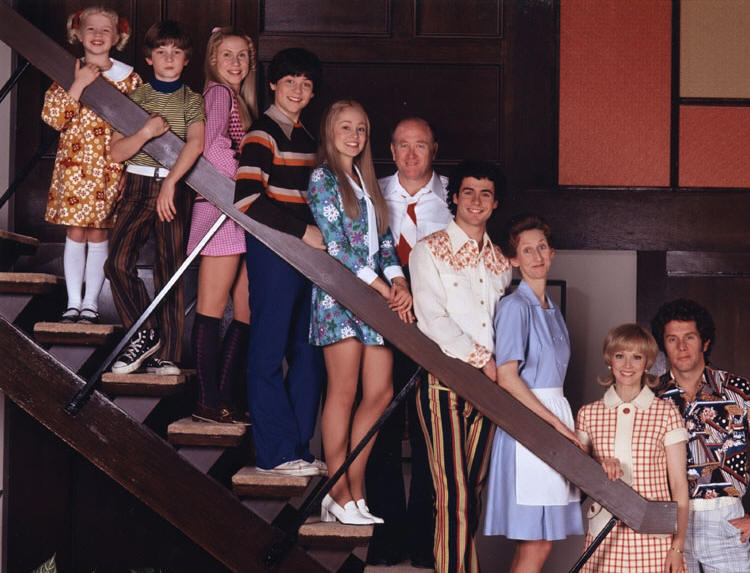 Tell
us something about a behind-the-scene incident that we never knew.
Tell
us something about a behind-the-scene incident that we never knew.
When the Bradys
were picked to do a laundry detergent commercial, some of it was
filmed [on location] in a market. When I arrived at the set, the
camera wasn’t where it was supposed to be. The previous night, we
had set up the shot. I said to the director, “What’s the deal?” And
there was a dead body where the camera was supposed to be. So we
filmed something else, and I went over to the guard and asked if he
knew anything about it. The guard said, “Yeah, he was my best
friend.” He was a guard who had died there. The dead body was
removed and then the kids came in and never knew that that happened.
Tell us about
Joe Namath’s guest appearance. He was a superstar at that time. What
made him do the show?
We wanted to get
a celebrity into the show, and we wondered how we were going to do
this. And I saw an article in the paper about Mike Connors [star of
Mannix], who had visited some kid in the hospital who was
very ill. And I said, that’s what I would do. If I were a kid, I
would call a celebrity and tell them I was dying. But dying was a
little too extreme for Brady. So Bobby pretended he was very sick.
Joe Namath wanted
to do it, and I remember Florence was crazy about him.
In general,
what are your feelings on the subsequent reunion projects?
The last year of
the show was not as happy as it could have been. Some of the kids
started going with a different manager and there was some division.
At the end of that, we said, okay, we’re done. When the reunion idea
came about, it was like a real family reunion, and all [the
animosity] was gone. It was very warm. Even Robert was okay.
They did the
Brady variety hour, which we didn’t even know was happening.
We only
found out about it because we saw that it was going to be on
television. The studio had the copyright, not us, and we were not
included. I tried to watch it and I could only watch half of one.
I’m glad that we didn’t have anything to do with it.
A Very Brady Christmas
[a CBS TV-movie in 1988] was an enormous hit. That was the highest
rated TV movie in two years. We just wanted to do occasional TV
movies, but it was such a hit that the network said that it should
be a series. They put [the series The Bradys] on at 8 o’
clock, but we didn’t have any little kids in it. It should have been
on at nine. I think it was a pretty good show, but it does not have
that reputation. It had a short, unhappy life.
The Brady
Bunch will continue to live on in its various forms, but the
original series remains the strongest of all the Brady projects.
Why?
One thing we
never did, except for the wardrobe, was anything that really
represented that time. It was really universal. There were no
catchphrases. It was always applicable. When it went on TV Land, it
really did well. It still does well, wherever it goes.
Little kids don’t
know anything about nostalgia. They just care about the story.
That’s why it’s successful, not because it was a “simpler time,” or
anything like that.
Email
us Let us know what you
think.